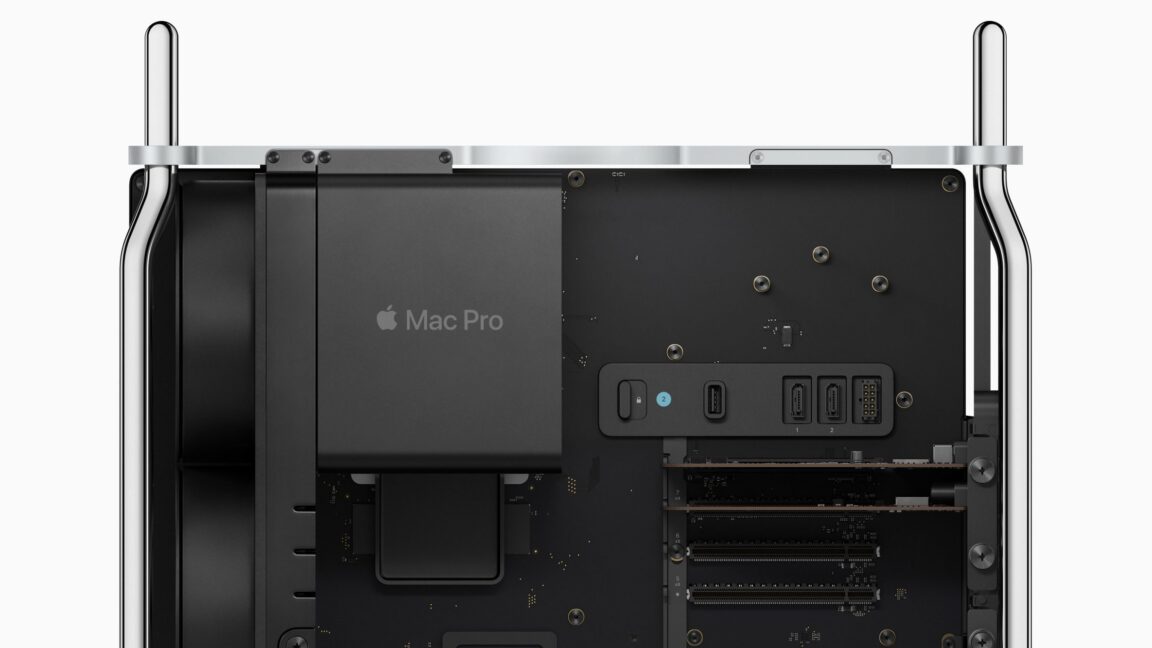
Credit: Apple
Apple’s Power Mac and Mac Pro towers used to be the company’s primary workstations, but it has been years since they were updated with the same regularity as the MacBook Air or MacBook Pro. The Mac Pro has seen just four hardware updates in the last 15 years, and that’s counting a 2012 refresh that was mostly identical to the 2010 version.
Long-suffering Mac Pro buyers may have taken heart when Apple finally added an M2 Ultra processor to the tower in mid-2023, making it one of the very last Macs to switch from Intel to Apple Silicon—surely this would mean that the computer would at least be updated once every year or two, like the Mac Studio has been? But Bloomberg’s Mark Gurman says that Mac Pro buyers shouldn’t get their hopes up for new hardware in 2026.
Gurman says that the tower is “on the back burner” at Apple and that the company is “focused on a new Mac Studio” for the next-generation M5 Ultra chip that is in the works. As we reported earlier this year, Apple doesn’t have plans to design or release an M4 Ultra, and the Mac Studio refresh from this spring included an M3 Ultra alongside the M4 Max.
Note that Gurman carefully stops short of saying we definitely won’t see a Mac Pro update next year—the emphasis on the Mac Studio merely “suggests the Mac Pro won’t be updated in 2026 in a significant way,” and internal sources tell him “Apple has largely written off the Mac Pro.” The current Mac Pro does still use the M2 Ultra rather than the M3 Ultra, which indicates that Apple doesn’t see the need to update its high-end desktop every time it releases a suitable chip. But all of Apple’s other desktops—the iMac, the Mac mini, and the Studio—have skipped a silicon generation once since the M1 came out in 2020.
Do we still need a Mac Pro, though?
Regardless of what Apple does with the Mac Pro, the desktop makes less sense than ever in the Apple Silicon era. Part of the appeal of the early 2010s and the 2019 Mac Pro towers was their internal expandability, particularly with respect to storage, graphics cards, and RAM. But while the Apple Silicon Mac Pro does include six internal PCI Express slots, it supports neither RAM upgrades nor third-party GPUs from Nvidia, AMD, or Intel. Thunderbolt 5’s 120 Gbps transfer speeds are also more than fast enough to support high-speed external storage devices.
That leaves even the most powerful of power users with few practical reasons to prefer a $7,000 Mac Pro tower to a $4,000 Mac Studio. And that would be true even if both desktops used the same chip—currently, the M3 Ultra Studio comes with more and newer CPU cores, newer GPU cores, and 32GB more RAM for that price, making the comparison even more lopsided.
Mac Pro aside, the Mac should have a pretty active 2026. Every laptop other than the entry-level 14-inch MacBook Pro should get an Apple M5 upgrade, with Pro and Max chips coming for the higher-end Pros. Those chips, plus the M5 Ultra, would give Apple all the ingredients it would need to refresh the iMac, Mac mini, and Mac Studio lineups as well.
Insistent rumors also indicate that Apple will be introducing a new, lower-cost MacBook model with an iPhone-class chip inside, a device that seems made to replace the 2020 M1 MacBook Air that Apple has continued to sell via Walmart for between $600 and $650. It remains to be seen whether this new MacBook would remain a Walmart exclusive or if Apple also plans to offer the laptop through other retailers and its own store.

-
 C114 Communication Network
C114 Communication Network -
 Communication Home
Communication Home


